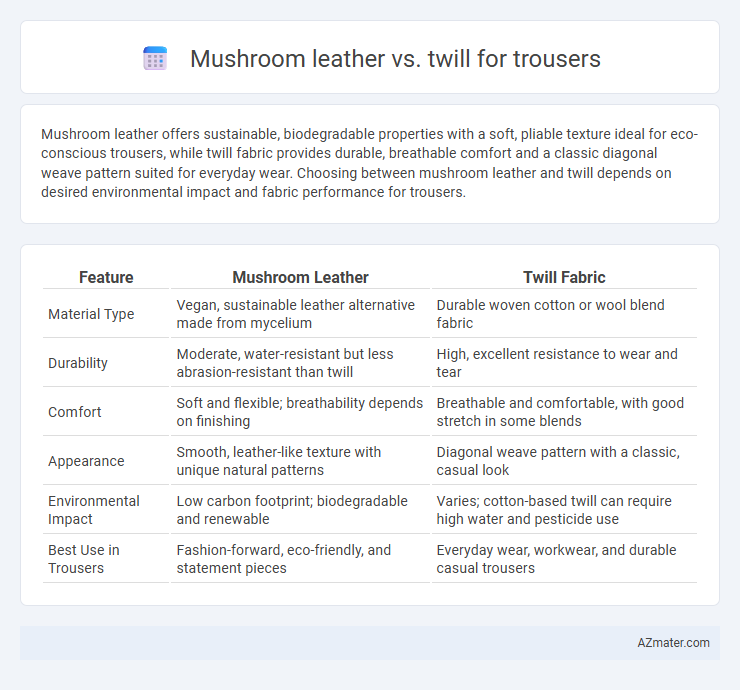Mushroom leather offers sustainable, biodegradable properties with a soft, pliable texture ideal for eco-conscious trousers, while twill fabric provides durable, breathable comfort and a classic diagonal weave pattern suited for everyday wear. Choosing between mushroom leather and twill depends on desired environmental impact and fabric performance for trousers.
Table of Comparison
| Feature | Mushroom Leather | Twill Fabric |
|---|---|---|
| Material Type | Vegan, sustainable leather alternative made from mycelium | Durable woven cotton or wool blend fabric |
| Durability | Moderate, water-resistant but less abrasion-resistant than twill | High, excellent resistance to wear and tear |
| Comfort | Soft and flexible; breathability depends on finishing | Breathable and comfortable, with good stretch in some blends |
| Appearance | Smooth, leather-like texture with unique natural patterns | Diagonal weave pattern with a classic, casual look |
| Environmental Impact | Low carbon footprint; biodegradable and renewable | Varies; cotton-based twill can require high water and pesticide use |
| Best Use in Trousers | Fashion-forward, eco-friendly, and statement pieces | Everyday wear, workwear, and durable casual trousers |
Introduction: Comparing Mushroom Leather and Twill for Trousers
Mushroom leather offers a sustainable, eco-friendly alternative featuring natural durability and water resistance, ideal for fashion-forward trousers. Twill fabric, known for its diagonal weave, provides breathability, comfort, and flexibility crucial for everyday wear. Choosing between mushroom leather and twill depends on the balance of sustainability, texture, and functional wearability in trouser design.
Material Origins and Sustainability
Mushroom leather originates from mycelium, the root structure of fungi, providing a biodegradable and renewable alternative to traditional animal leather. Twill fabric is typically woven from cotton or synthetic fibers, with cotton requiring substantial water and pesticide use, impacting environmental sustainability. Mushroom leather offers a more eco-friendly production process by minimizing chemical inputs and waste, while twill's sustainability depends heavily on the fiber source and agricultural practices involved.
Environmental Impact: Mushroom Leather vs Twill
Mushroom leather, made from sustainable mycelium, offers a biodegradable alternative with a significantly lower carbon footprint compared to traditional twill fabric, which often relies on resource-intensive cotton production. The cultivation of mycelium requires minimal water and land, reducing environmental degradation associated with twill's heavy pesticide and water usage. Mushroom leather's renewable nature and reduced chemical processing contribute to a more eco-friendly lifecycle, positioning it as a greener option for trousers.
Durability and Longevity
Mushroom leather, made from sustainable mycelium, offers a flexible yet resilient material ideal for trousers, exhibiting strong resistance to wear and moderate water resistance, ensuring reliable durability in everyday use. Twill fabric, typically woven from cotton or wool, provides excellent strength and abrasion resistance, contributing to long-lasting trousers that maintain shape and comfort through frequent wear and washing. While mushroom leather delivers innovative eco-friendly benefits with respectable durability, twill remains superior in overall longevity and ease of maintenance for extended garment life.
Comfort and Breathability
Mushroom leather offers superior breathability compared to twill due to its natural porous structure, allowing better air circulation and moisture management. Twill fabric, typically made from cotton or polyester blends, provides moderate breathability but can retain heat and moisture during extended wear. Comfort-wise, mushroom leather molds to the body over time offering a flexible and lightweight feel, while twill maintains a firmer texture and may cause slight discomfort in warmer climates.
Aesthetic Appeal and Style Options
Mushroom leather offers a unique, eco-friendly aesthetic with a smooth, matte finish that adds a modern, avant-garde edge to trousers, appealing to sustainable fashion enthusiasts. Twill fabric provides classic versatility with its diagonal weave, available in various colors and patterns, making it ideal for both casual and formal styles. The choice between mushroom leather and twill hinges on whether a bold, innovative look or a timeless, adaptable style is preferred.
Care and Maintenance Requirements
Mushroom leather requires gentle cleaning with a damp cloth and should be kept away from excessive moisture to prevent damage, making it less durable under heavy wear conditions. Twill fabric is more resilient, allowing for machine washing and easier stain removal, which enhances its practicality for everyday trousers. Regular maintenance of mushroom leather includes conditioning to preserve flexibility, while twill benefits from occasional ironing to maintain its crisp appearance.
Cost Comparison and Market Availability
Mushroom leather generally carries a higher price point than twill fabric, attributed to its innovative, sustainable production methods and limited manufacturing scale. Twill, widely available in various compositions such as cotton and polyester, offers a cost-effective option with extensive market accessibility and established supply chains. The emerging mushroom leather market is expanding but remains niche, predominantly favored in premium and eco-conscious apparel segments.
Suitable Use Cases and Lifestyle Compatibility
Mushroom leather offers a sustainable and water-resistant option ideal for eco-conscious consumers seeking durable, weatherproof trousers suited for outdoor activities and casual wear. Twill fabric provides breathability and flexibility, making it perfect for everyday comfort, office environments, and casual to semi-formal occasions. Lifestyle compatibility with mushroom leather suits active individuals prioritizing sustainability, while twill caters to those valuing versatility and ease of movement in varied settings.
Conclusion: Choosing the Ideal Material for Trousers
Mushroom leather offers a sustainable, vegan alternative with durability and water resistance, ideal for eco-conscious fashion. Twill fabric provides breathability, comfort, and flexibility, making it perfect for everyday wear and diverse climates. Selecting the ideal material depends on balancing environmental impact with desired durability and comfort for trousers.

Infographic: Mushroom leather vs Twill for Trousers
 azmater.com
azmater.com